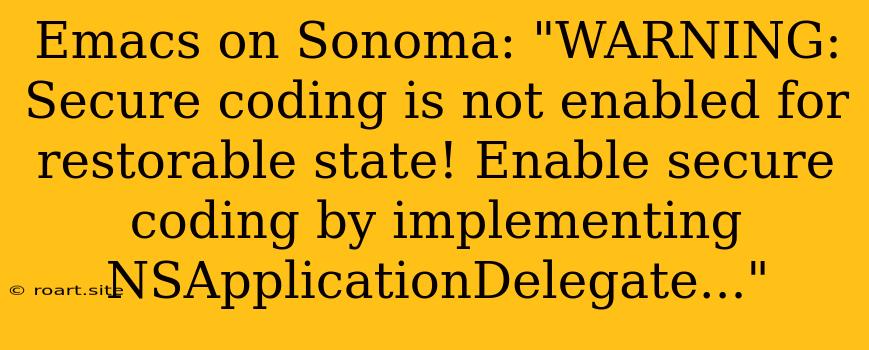The recent release of macOS Sonoma has brought with it a number of changes, including a new security feature that can impact how Emacs operates. This feature, aimed at bolstering user security, prompts users with a warning message: "WARNING: Secure coding is not enabled for restorable state! Enable secure coding by implementing NSApplicationDelegate...". This message, while appearing intimidating, is actually a straightforward indication that Emacs needs a small configuration adjustment to fully integrate with Sonoma's security measures. This article will guide you through understanding the warning and the steps needed to resolve it, ensuring a smooth and secure Emacs experience on your Sonoma system.
Understanding the Sonoma Security Feature
macOS Sonoma introduces a security enhancement that prioritizes user data protection. This feature, implemented as part of the system's "restorable state" mechanism, aims to prevent unauthorized access to user data stored within applications. When an application attempts to access this sensitive data without adhering to the new security protocols, Sonoma displays the warning message. In the case of Emacs, this warning arises because its default configuration doesn't explicitly implement the necessary security protocols.
Why This Warning Appears for Emacs
Emacs, as a powerful and highly customizable editor, utilizes a variety of features that can potentially interact with user data. This data includes settings, buffers, and other user-specific information. The Sonoma security feature detects that Emacs, in its default configuration, doesn't explicitly declare its intent to handle this data securely.
Resolving the "Secure Coding" Warning
Resolving the "WARNING: Secure Coding is not enabled for restorable state! Enable secure coding by implementing NSApplicationDelegate..." warning is a simple process. You'll need to make a minor adjustment to Emacs' configuration. This involves adding a specific line to your Emacs initialization file, typically located at ~/.emacs.d/init.el.
The Solution: Implementing NSApplicationDelegate
The solution lies in implementing the NSApplicationDelegate protocol. This protocol, provided by macOS, ensures that Emacs adheres to the necessary security standards for handling user data. To implement this, simply add the following line to your init.el file:
(setq ns-application-delegate-class 'emacs-application-delegate)
This line instructs Emacs to use the emacs-application-delegate class, which provides the necessary implementation for the NSApplicationDelegate protocol.
Steps for Implementing the Solution
-
Locate Your
init.elFile: Theinit.elfile is located within your Emacs configuration directory, typically found at~/.emacs.d/. -
Edit
init.el: Open theinit.elfile using your preferred text editor. -
Add the Line: Paste the following line into the
init.elfile. Make sure it is placed outside any existing function definitions or conditional blocks.(setq ns-application-delegate-class 'emacs-application-delegate) -
Save and Restart Emacs: Save the
init.elfile and restart Emacs.
Verification and Further Considerations
After implementing the solution, the "WARNING: Secure coding is not enabled for restorable state! Enable secure coding by implementing NSApplicationDelegate..." message should no longer appear. If the warning persists, double-check the following:
- Correct File Location: Ensure that the
init.elfile is correctly located at~/.emacs.d/. - Line Placement: Verify that the
(setq ns-application-delegate-class 'emacs-application-delegate)line is placed outside any function definitions or conditional blocks.
While implementing NSApplicationDelegate ensures Emacs' adherence to Sonoma's security standards, it's also a good practice to review your Emacs configuration for any potential security risks.
Conclusion
The "WARNING: Secure coding is not enabled for restorable state! Enable secure coding by implementing NSApplicationDelegate..." message is a security measure introduced by macOS Sonoma to protect user data. By implementing NSApplicationDelegate in your Emacs configuration, you ensure that your Emacs editor seamlessly integrates with Sonoma's security features. This simple modification enables you to enjoy a secure and enjoyable Emacs experience on your Sonoma system, while also contributing to the overall security of your macOS environment.
